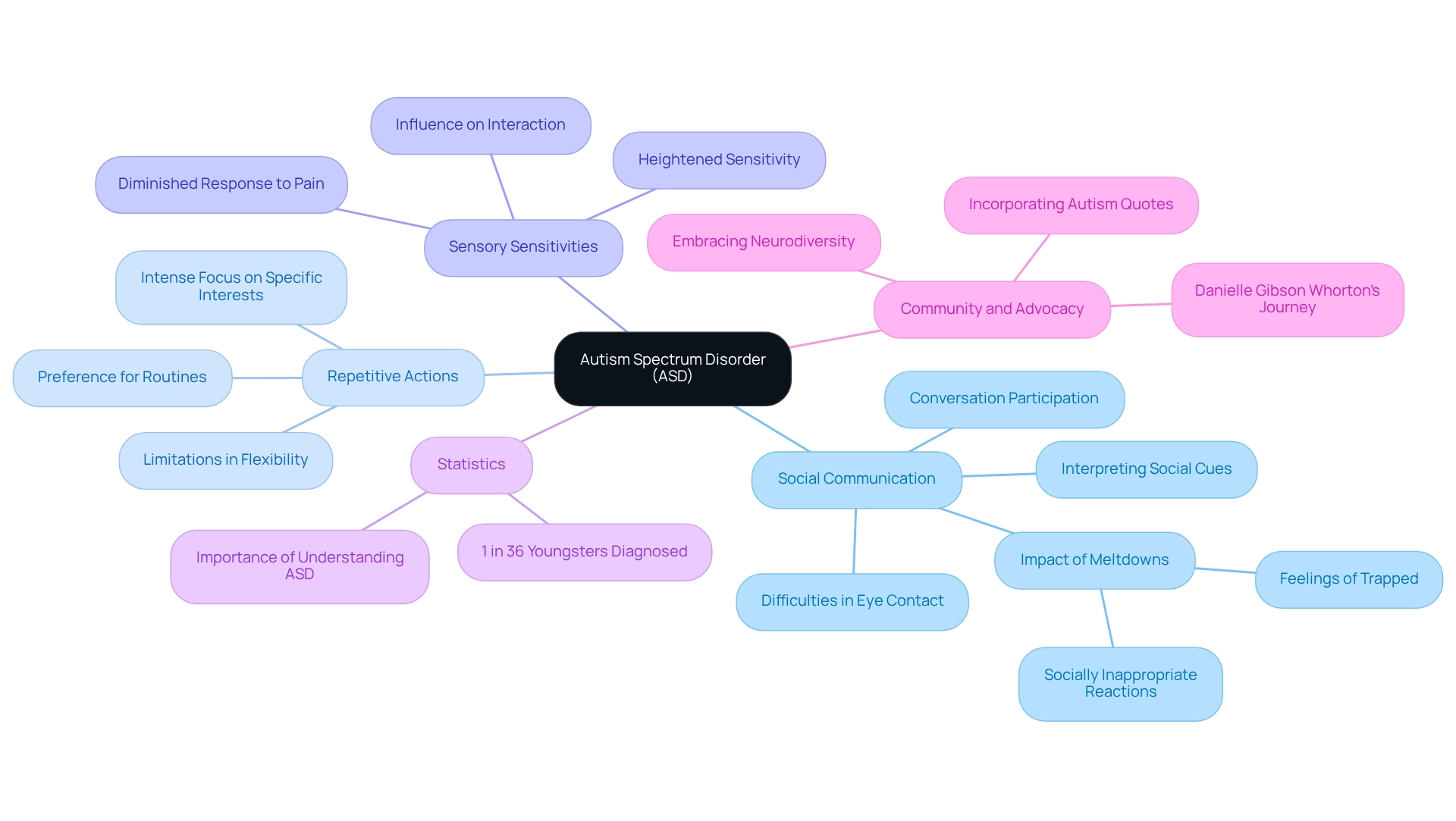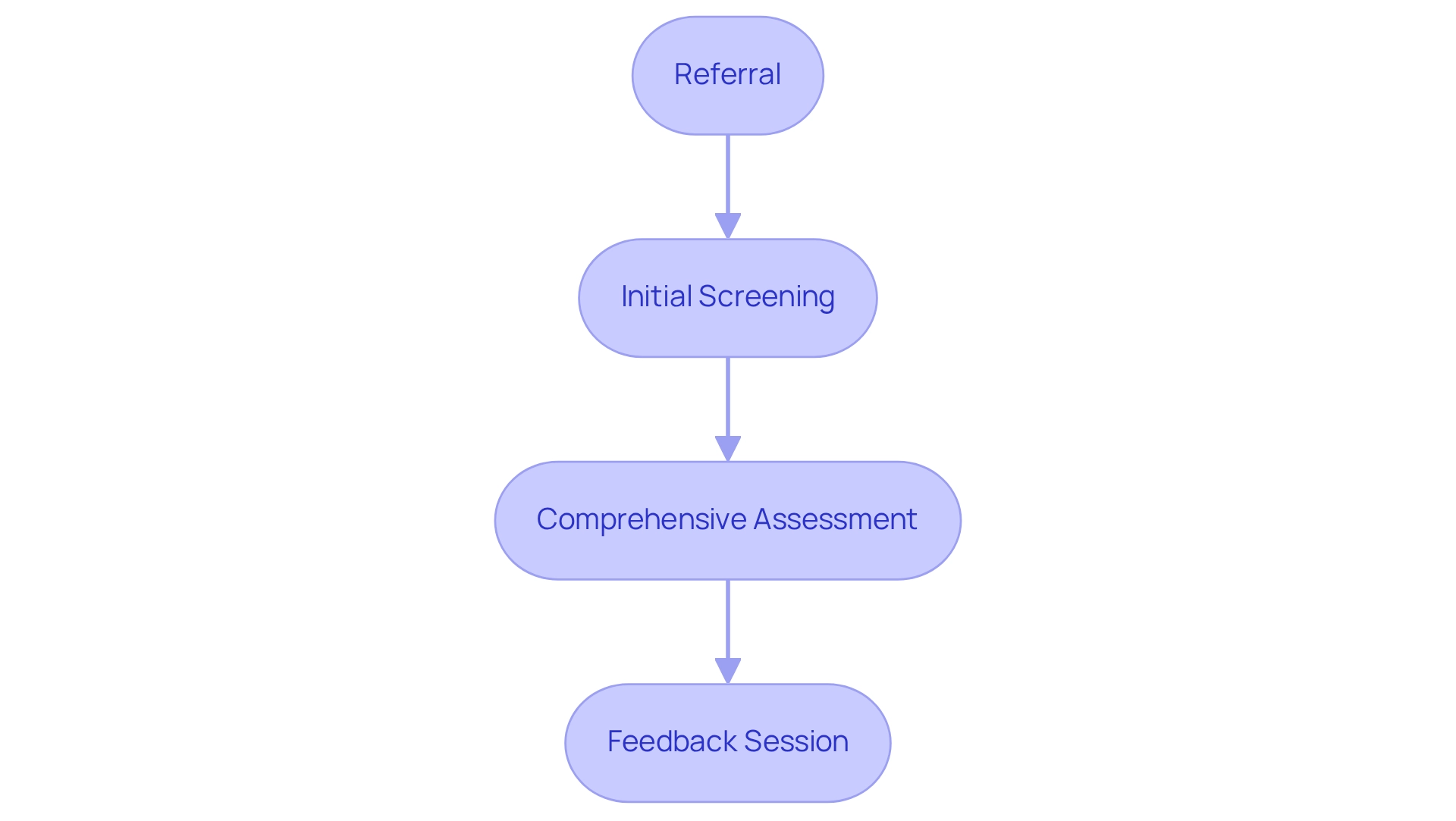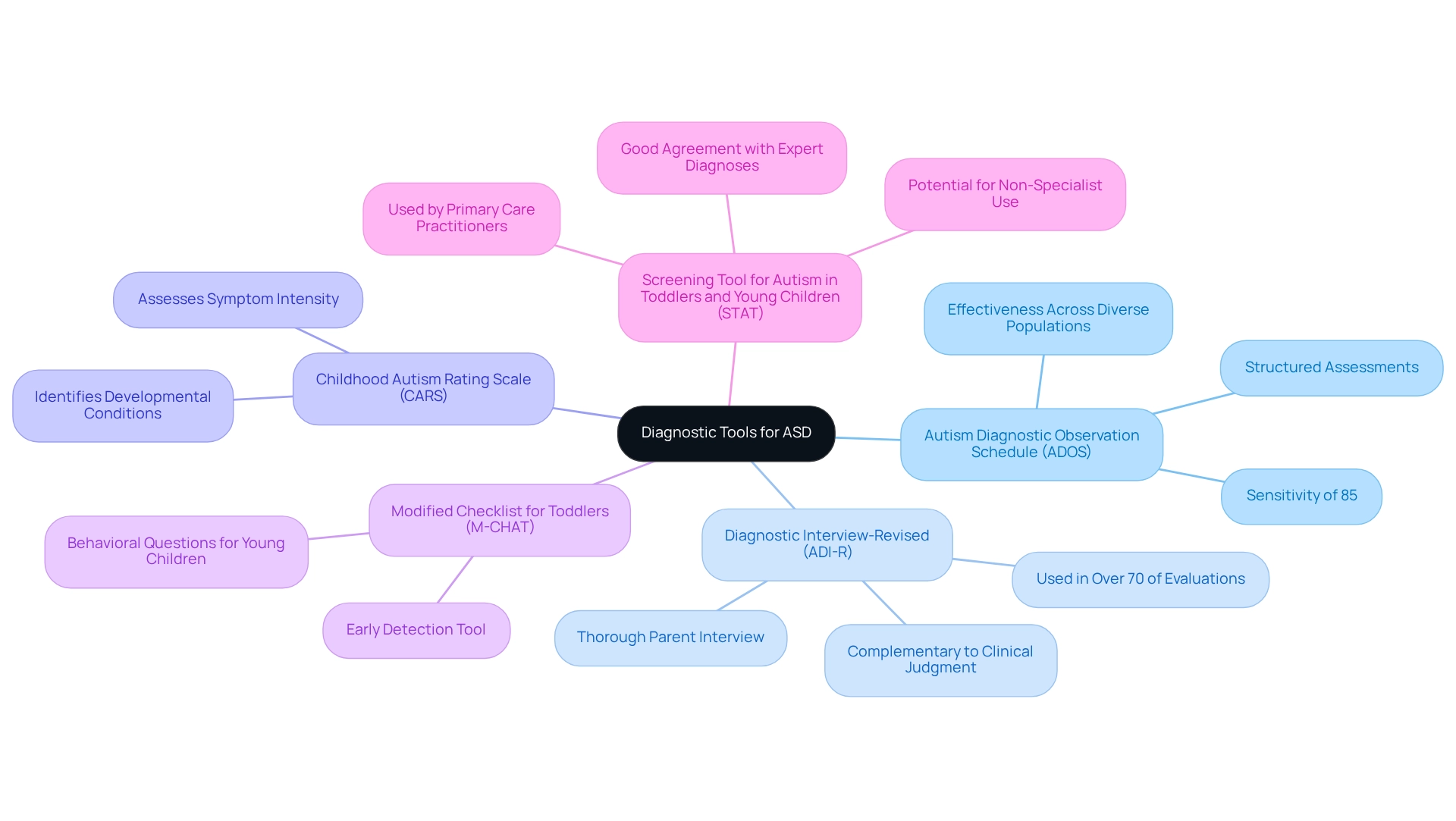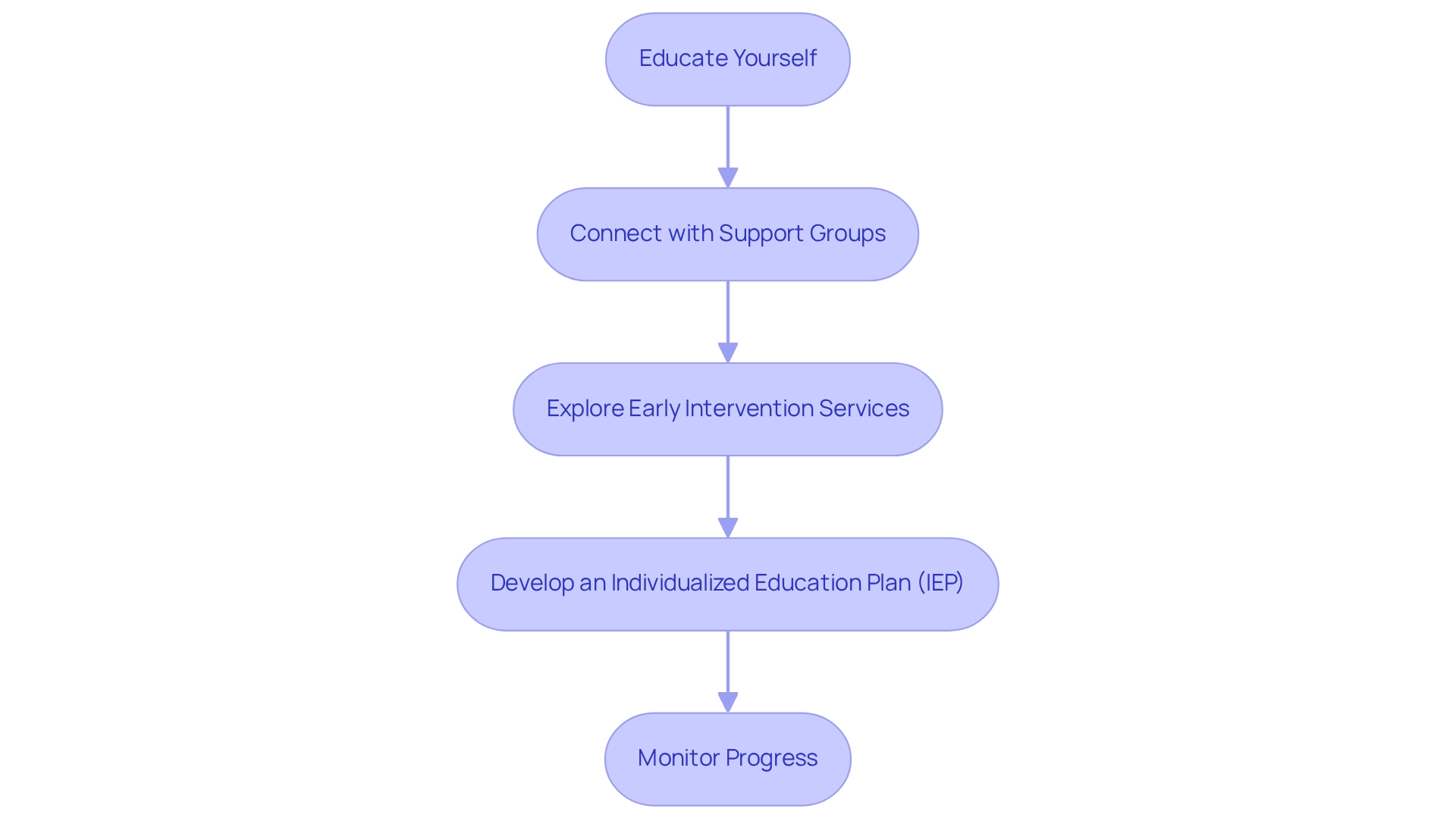Overview
The article titled "Understanding the Autism Test Kids: A Comprehensive Guide" serves as a compassionate resource for families exploring the autism evaluation process. It sheds light on key concepts related to Autism Spectrum Disorder (ASD) and the diagnostic tools that can help assess it.
Understanding social communication challenges, repetitive behaviors, and sensory sensitivities in children with ASD is crucial, and this guide details the evaluation steps and various diagnostic tools that support accurate assessments.
Ultimately, it aims to guide families toward effective support and interventions, fostering a nurturing environment for their loved ones.
Introduction
Autism Spectrum Disorder (ASD) is a complex neurodevelopmental condition that affects millions of children worldwide. It presents unique challenges in social communication, behavior, and sensory processing that can be overwhelming for families. As the prevalence of ASD continues to rise, with current statistics indicating that approximately 1 in 36 children are diagnosed, understanding the core concepts and the evaluation process becomes increasingly vital for families and professionals alike.
This article seeks to shed light on the intricacies of ASD, outlining essential definitions and the diagnostic journey. We will explore the tools used to assess the condition and offer guidance on navigating the post-diagnosis landscape.
Education, community support, and tailored interventions are crucial in empowering children with autism to thrive, and together, we can foster an environment where these children can flourish.
Clarify Autism Spectrum Disorder: Key Concepts and Definitions
Autism Spectrum Disorder (ASD) is a complex neurodevelopmental condition that can present significant challenges for both children and their families. Characterized by persistent difficulties in social communication, limited interests, and repetitive actions, the term 'spectrum' reflects the diverse range of symptoms and severity levels associated with this disorder. Understanding these key concepts is essential for parents and caregivers navigating this journey.
- Social Communication: Children with ASD often encounter obstacles in understanding and engaging in social interactions. This may manifest as difficulties in maintaining eye contact, participating in conversations, and interpreting social cues. Such challenges can lead to misunderstandings and frustration. As Chi describes, during meltdowns, young individuals may feel trapped and overwhelmed, experiencing a surge of emotions that can result in socially inappropriate reactions.
- Repetitive Actions: Repetitive behaviors may include movements, a strong preference for routines, and intense focus on specific interests. While these actions can provide comfort, they may also limit flexibility in social situations, making it crucial for families to recognize and address these behaviors compassionately.
- Sensory Sensitivities: Many individuals with ASD have atypical responses to sensory stimuli, ranging from heightened sensitivity to certain sounds or textures to a diminished response to pain. These sensitivities significantly influence how they interact with their environment and can be a source of distress.
Current statistics indicate that approximately 1 in 36 youngsters are diagnosed through autism tests in 2025, highlighting the increasing prevalence of this condition. This statistic underscores the importance of understanding these core concepts for parents and professionals as they navigate the autism evaluation process and seek effective interventions. As O. Ivar Lovaas wisely noted, 'If they can't learn the way we instruct, we instruct the way they comprehend.' This highlights the necessity for personalized approaches in education.
Recent studies emphasize the importance of addressing social communication difficulties. Effective interactions during stressful situations can prevent unintended outcomes and improve the overall experience for individuals with ASD. By fostering a supportive environment that values neurodiversity, families can empower their children to thrive.
The journey of Danielle Gibson Whorton in supporting Autism Speaks illustrates the profound impact of community and advocacy, reinforcing the supportive environment that families can create. Incorporating quotes related to neurodiversity into daily life can also provide strength and motivation for individuals on the spectrum and their families, enhancing their understanding and support.

Outline the Autism Evaluation Process: What to Expect
Navigating the autism evaluation process can be daunting for parents, but understanding the steps involved can empower you and provide reassurance. It often begins with a Referral: parents discuss their concerns with a pediatrician, who may guide them to a specialist who can help.
Next comes the Initial Screening. This step may include questionnaires or checklists designed to evaluate developmental milestones and behaviors, helping to identify any areas of concern.
Following this, a Comprehensive Assessment is conducted by a multidisciplinary team. This detailed evaluation may involve interviews, observations, and standardized tests, including specific autism assessments for children, aimed at gauging communication and social skills.
Finally, there’s the Feedback Session. After the evaluation, parents meet with specialists to discuss the findings, recommendations, and the next steps in the journey.
By comprehending this process, you can feel more prepared and actively involved in your child's evaluation. Remember, you are not alone in this journey—many parents share similar experiences and concerns. We encourage you to reach out, share your thoughts, and seek support. Together, we can navigate this path with understanding and compassion.

Explore Diagnostic Tools: Tests and Their Interpretations
Understanding Autism Spectrum Disorder (ASD) can be a daunting journey for parents, but a variety of diagnostic tools are here to help. Each tool offers unique insights into a child's behavior and development, guiding you toward a clearer understanding of their needs.
- Autism Diagnostic Observation Schedule (ADOS): Imagine observing your child during play and social interactions. The ADOS provides structured assessments that yield critical data for diagnosis. Recent updates show its effectiveness across diverse populations, with studies highlighting a strong agreement with expert diagnoses. Notably, the ADOS demonstrates a sensitivity of about 85% in recognizing autism spectrum conditions in various environments.
- Diagnostic Interview-Revised (ADI-R): This thorough interview with parents focuses on your child's developmental history and present behaviors. While the ADI-R is crucial in the diagnostic process, it should not be the sole basis for diagnosis. Instead, it’s essential to complement it with clinical judgment and information from various sources. Recent studies reveal that the ADI-R is utilized in over 70% of evaluations for individuals on the spectrum, underscoring its importance.
- Childhood Autism Rating Scale (CARS): Recognizing the challenges your child faces is vital. The CARS tool helps identify youth with developmental conditions and assess the intensity of their symptoms, providing a nuanced understanding of their strengths and areas for growth.
- Modified Checklist for Toddlers (M-CHAT): Early detection is key. This screening instrument, designed for young children, includes a set of questions about their behavior, aiding in identifying developmental risks early on.
Each of these tools plays a pivotal role in guiding clinicians toward accurate diagnoses, ultimately enhancing outcomes for children undergoing autism assessments. By integrating these evaluations with expert opinions and real-world applications, we highlight the importance of a comprehensive approach. As the National Institute for Health and Care Excellence states, "A diagnosis should not be based on any autism-specific diagnostic instrument alone but should be informed by information from a range of sources, together with clinical judgment."
Moreover, a case study on the Screening Tool for Toddlers and Young Children (STAT) showcased its effectiveness when used by primary care practitioners, emphasizing its precision and potential for application by non-specialists. This holistic approach is essential for ensuring that young individuals receive the support they truly need. If you have experiences or questions, please share them in the comments or through our newsletter; your insights matter.

Navigate Post-Diagnosis: Next Steps and Resources for Support
After receiving an autism diagnosis, families often find themselves navigating a complex landscape. It’s crucial to take several important steps to ensure that your child receives the support they need.
- Educate Yourself: Understanding Autism Spectrum Disorder (ASD) is vital. Dive into resources from reputable organizations like Autism Speaks and the CDC. Staying informed about the condition and available interventions can empower you as a caregiver.
- Connect with Support Groups: Engaging with other parents can be incredibly beneficial. Support groups provide not just emotional backing but also practical guidance, fostering a sense of community that is essential for overcoming the challenges of developmental disorders. In fact, surveys reveal that 36.5% of autism caregivers utilize ABA therapy, with many reporting positive outcomes. These groups are invaluable for sharing experiences and strategies.
- Explore Early Intervention Services: Research indicates that early intervention services, especially those that include Applied Behavior Analysis (ABA) therapy, can lead to significant improvements in developmental outcomes. Additionally, therapies based on cognitive behavioral therapy (CBT) can be effective when tailored to the unique needs of autistic individuals. Seeking local programs that offer customized support can help maximize your child’s potential.
- Develop an Individualized Education Plan (IEP): For school-aged children, collaborating with educators to create an IEP is essential. This plan should be specifically designed to meet your child’s individual needs, ensuring they receive appropriate educational support.
- Monitor Progress: Regularly assessing your child’s development is crucial. By collecting data on their progress—like what’s highlighted in the case study 'The Role of Data Collection in ABA'—you can make informed decisions about adjusting strategies and interventions to better support their growth.
These steps not only assist families in navigating the post-diagnosis journey but also empower you to advocate effectively for your child's needs. By ensuring access to vital resources and support, you play a pivotal role in fostering their development.

Conclusion
Understanding Autism Spectrum Disorder (ASD) is crucial in today’s world, where approximately 1 in 36 children are diagnosed with this complex condition. This article has shed light on the key concepts of ASD, including the challenges in social communication, the significance of repetitive behaviors, and the impact of sensory sensitivities. Recognizing these aspects is essential for families and professionals alike as they embark on the diagnostic journey and seek effective interventions.
The evaluation process for autism involves a series of structured steps—from initial referrals to comprehensive assessments—enabling families to engage meaningfully in their child's diagnostic experience. Utilizing diagnostic tools such as the Autism Diagnostic Observation Schedule and the Autism Diagnostic Interview-Revised ensures a thorough understanding of the child’s unique challenges and strengths, paving the way for tailored support.
Post-diagnosis, families are empowered to take proactive steps to support their children. By educating themselves, connecting with support networks, exploring early intervention services, and developing Individualized Education Plans (IEPs), they can navigate the complexities of autism with confidence. Monitoring progress and adapting interventions further enhances the potential for positive outcomes.
Ultimately, fostering an inclusive environment where children with ASD can thrive is a collective responsibility. Embracing neurodiversity and advocating for tailored interventions not only benefits children with autism but enriches communities as a whole. Together, by prioritizing understanding, support, and advocacy, we can create a brighter future for all children on the autism spectrum.
Frequently Asked Questions
What is Autism Spectrum Disorder (ASD)?
Autism Spectrum Disorder (ASD) is a complex neurodevelopmental condition characterized by persistent difficulties in social communication, limited interests, and repetitive actions. The term 'spectrum' reflects the diverse range of symptoms and severity levels associated with the disorder.
What are the main challenges faced by children with ASD?
Children with ASD often face challenges in social communication, which can include difficulties in maintaining eye contact, participating in conversations, and interpreting social cues. They may also exhibit repetitive actions and have sensory sensitivities that influence their interactions with the environment.
How do social communication difficulties manifest in children with ASD?
Social communication difficulties in children with ASD may manifest as trouble understanding and engaging in social interactions, leading to misunderstandings and frustration. During meltdowns, they may feel trapped and overwhelmed, resulting in socially inappropriate reactions.
What are some examples of repetitive actions in children with ASD?
Repetitive actions in children with ASD may include movements, a strong preference for routines, and intense focus on specific interests. While these behaviors can provide comfort, they may limit flexibility in social situations.
What are sensory sensitivities in individuals with ASD?
Many individuals with ASD have atypical responses to sensory stimuli, which can include heightened sensitivity to certain sounds or textures and a diminished response to pain. These sensitivities can significantly affect how they interact with their environment and may cause distress.
What are the current statistics regarding the diagnosis of ASD?
Current statistics indicate that approximately 1 in 36 youngsters are diagnosed with ASD through autism tests in 2025, highlighting the increasing prevalence of this condition.
Why is it important for parents and professionals to understand the core concepts of ASD?
Understanding the core concepts of ASD is essential for parents and professionals as they navigate the autism evaluation process and seek effective interventions. It helps in creating personalized approaches in education and support.
How can families support children with ASD effectively?
Families can support children with ASD by fostering a supportive environment that values neurodiversity, addressing social communication difficulties, and incorporating quotes related to neurodiversity into daily life to enhance understanding and motivation.
What does the journey of Danielle Gibson Whorton illustrate about community and advocacy for ASD?
The journey of Danielle Gibson Whorton in supporting Autism Speaks illustrates the profound impact of community and advocacy, reinforcing the importance of creating a supportive environment for families and individuals with ASD.




